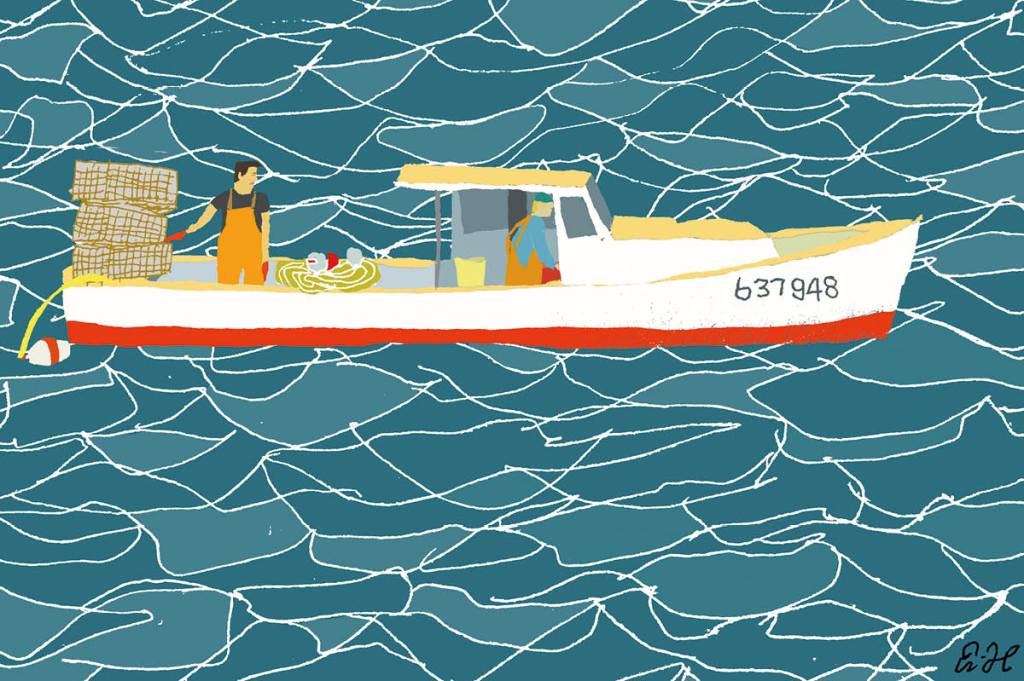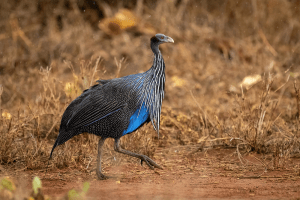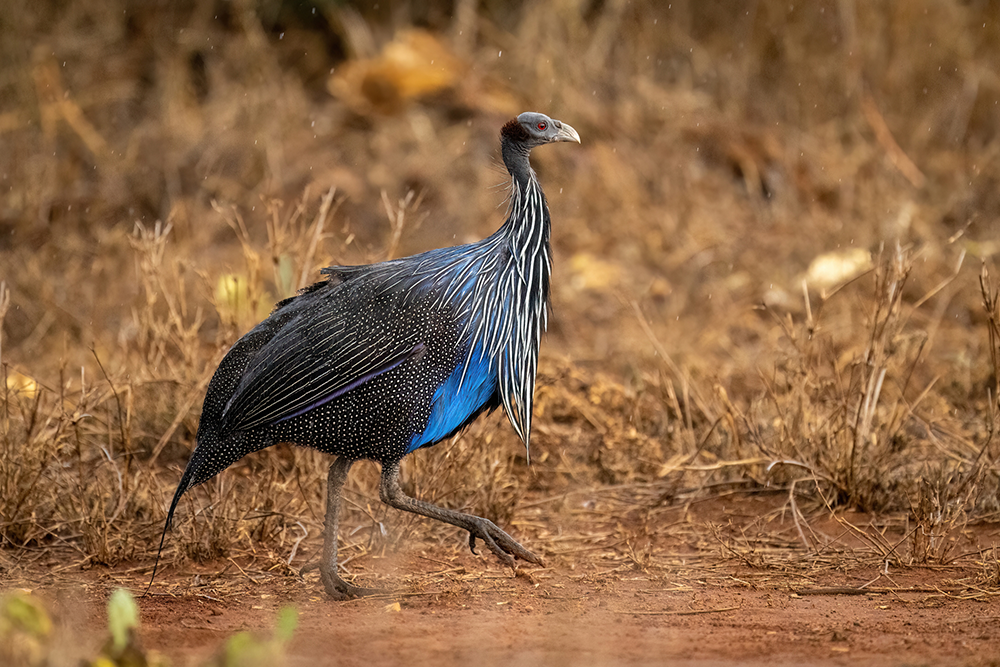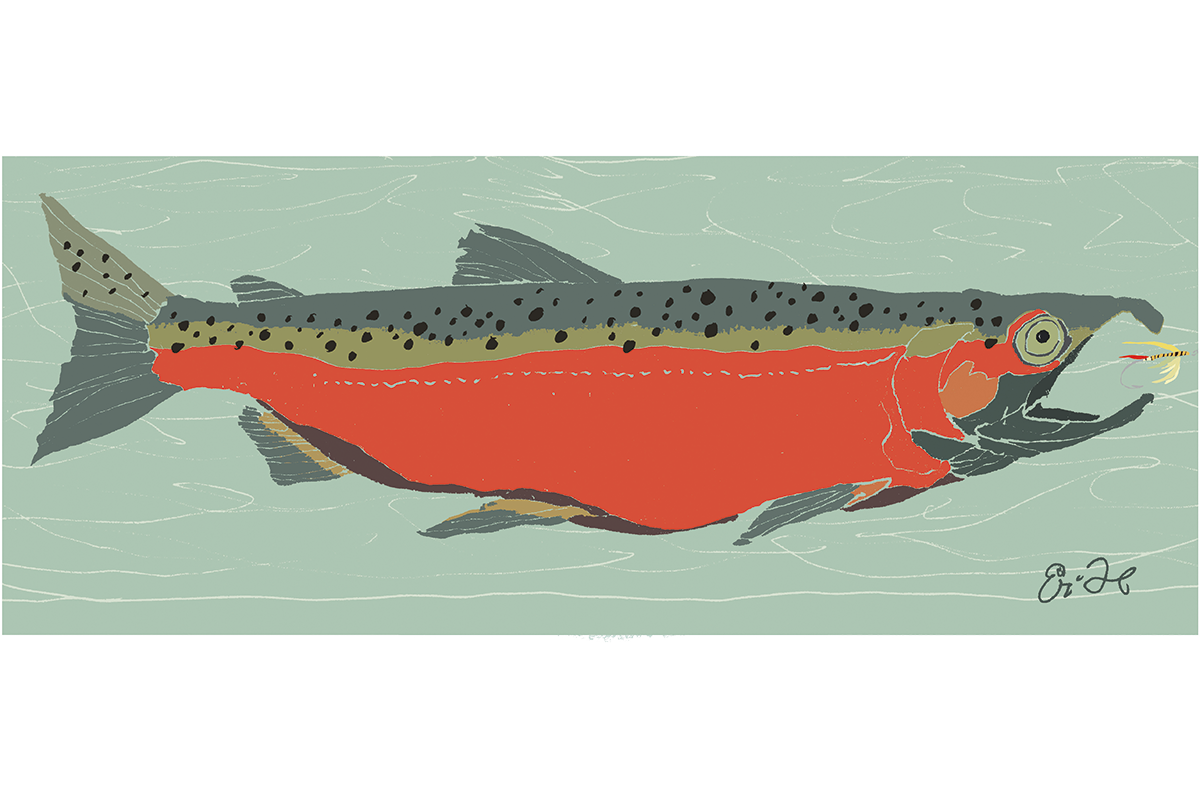It’s 5 a.m. in early May in Harpswell, Maine — “a working waterfront” community. I’m sipping coffee on the deck of Mark and Judy Sgantas’s charming home. The Sgantases are distressed about the government overreach and so-called “green energy” initiatives their neighbors have told them are apt to destroy the New England maritime economy and communities. We keep our voices soft so as not to disturb sleepy Casco Bay and the peach-and-plum masterpiece gradually unveiling itself in the sky and reflecting on the still water.
An hour later, dawn is ablaze and Tylor, a sternman on the Hailey Elizabeth, is shouting over the hum of the boat’s motor and the surging sea and the blare of WBLM — “Maine’s Classic Rock Station” — instructions for skewering the hundreds of decomposing fish piled in front of me, waiting to become bait.
We’re preparing to catch lobsters. Traps have been laid 300-plus-feet down on the ocean floor, and for the next nine or so hours, boat owner and captain Matt Clemons runs the boat to buoys marked with his registered colors (the nautical equivalent of a brand on beef cattle). He and Riley, the vessel’s other sternman, use a winch to haul lines of fifty-five-pound traps up onto the boat. They remove trapped lobsters, measure them, toss them back into the water if they’re longer than five inches or shorter than three-and-a-quarter inches, v-notch and toss lobsters back automatically if they’re carrying eggs or have been notched previously, and place the future halves of surf-and-turf dinners in a basket on deck. Tylor simultaneously rebaits the emptied traps and lines them up on the back of the boat, while I cling to the side of the bait station and stay far, far away from the ropes dragging the traps — kerplunk — back to the bottom of the sea.
The men work swiftly, assembly-line style, and except for a very brief lunchbreak, nonstop. While Matt guides the boat to the next buoy, the sternmen are busy preparing a new batch of bait and banding the claws of the keepers.
It’s a brilliant day to be surrounded by the sea. We’re many miles offshore, and land is a barely perceptible speck in the distance. After hours of observing the men work as rhythmically as machines and helping a bit with the bait, the continual rock of the boat and the endless expanse all around leaves me entranced and slightly disoriented.
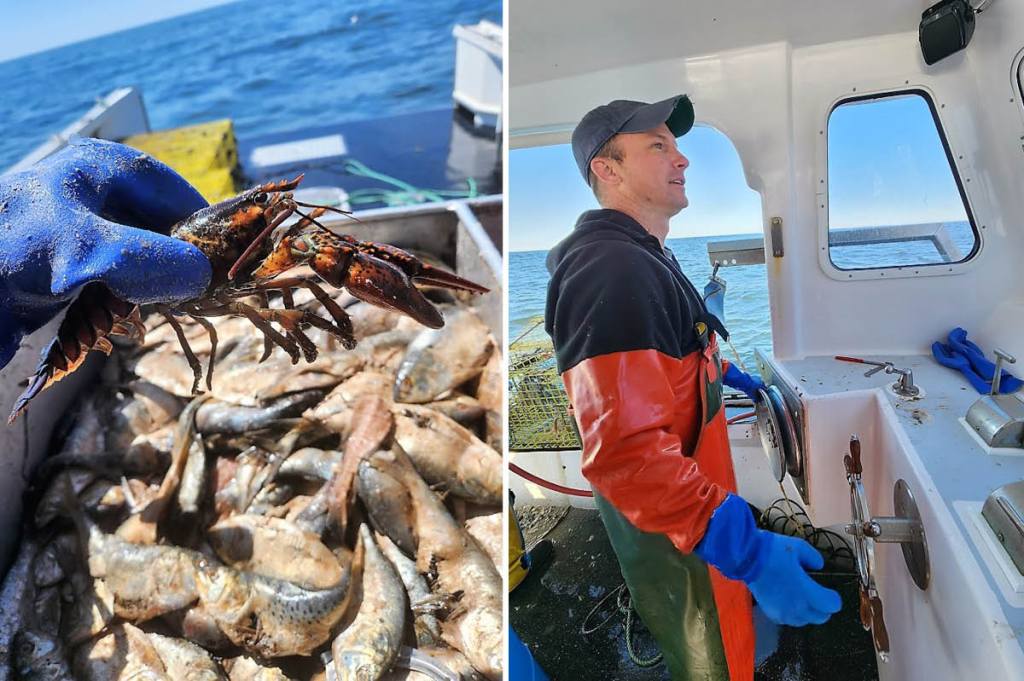
Time to ground myself, so to speak. And so I remember what I am here to find out: what does Matt think of the ramping-up of federal red tape, the catastrophic effects of which I’ve heard about from other New England fishermen and lobstermen? I head to the wheelhouse to ask him.
“The main thing is just the constant cloud over our head of a total shutdown,” he says. “I’d like the guarantee of a future, really. And it’s not just for me. I have four kids. Twenty years ago, I’d be like, ‘You gotta get into [this industry].’ Now, I don’t even know if that’s something you should push. There’s a wharf culture and a community culture, and that’s just dying, and it’s really, really sad.”
Matt lists federal rules restricting catch quotas; shortening fishing seasons; implementing expensive and onerous permitting requirements and rules mandating net sizes with a lower yield than those of Canadian competitors; and insisting that lobstermen use complicated, costly “ropeless” gear as reasons he and fellow lobstermen and fishermen fear for their livelihoods.
These regulations are the reason Jerry Leeman traded his twenty-two-year career as a commercial groundfisherman for the executive director role of the New England Fisherman Stewardship Association (NEFSA), a newly formed non-profit, nonpartisan advocacy group fighting “against needless regulation and offshore wind development threatening the viability of the American fishing fleet.”
Jerry was at home, winding down after a ten-day trip at sea, when he saw a television report of “the lowest landings of codfish in Maine’s history due to overfishing.”
“I was like, ‘You’ve got to be shitting me!’” Jerry recalls. “I’ve seen more fish now than twenty years ago when I first started fishing. I wanted to throw the damn clicker through the TV.
“I stewed on it,” Jerry continues. “Then I opened my mouth and I put my foot in it and now I have to chew it.”
Despite having spent more time on water than land in his life, Jerry has hit the ground running with NEFSA. He travels all over New England and to Washington, DC, meeting with stakeholders, lawmakers and agency directors. He’s been sounding the alarm to major media outlets and anyone who will listen about the myriad ways government policies are destroying the industry and heritage of so many New England families and threatening our national food security and fishing future.
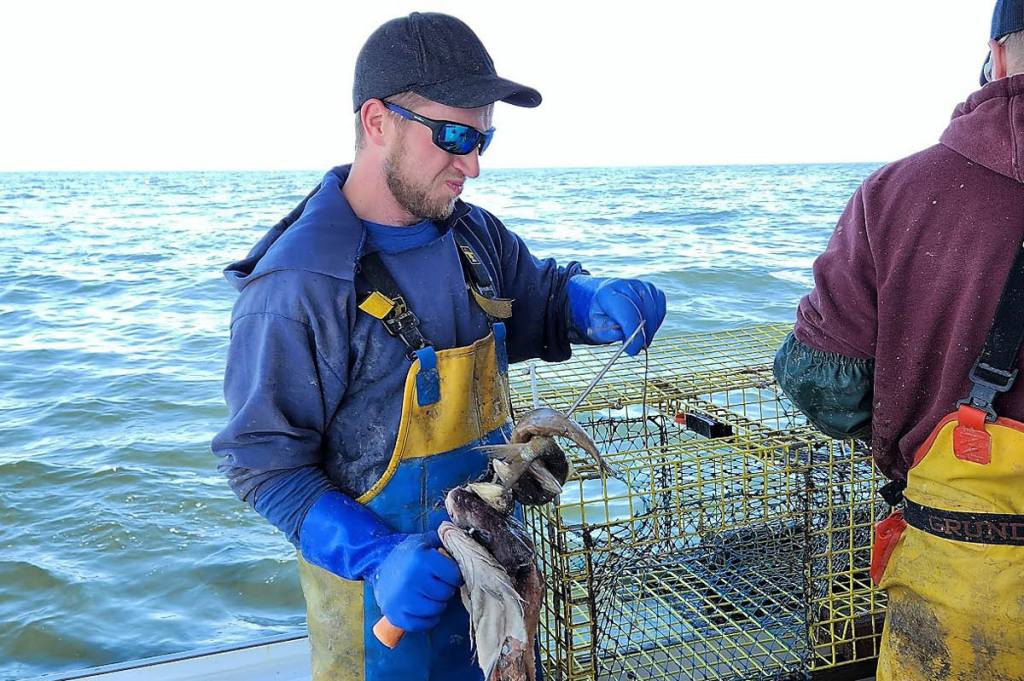
These mandates have “been eating at me and other captains for years,” Jerry says. Yet it is the more recent proposal of a ten-million-acre offshore wind energy project in the Gulf of Maine that has really united the historically rivalrous lobstermen and fishermen. Sinking turbines into the ocean would obstruct the seafloor and prevent trawlers and lobstermen from doing their work. NEFSA also cites European studies that have found that “cables carrying energy inland from wind farms can change fish migration patterns and deplete populations.” Construction noise can cause similar harm, “depleting our stocks without even touching our stocks,” as Jerry puts it. “There’s not one alive who agrees with it.”
George Prince, a NEFSA member who has been involved in the fishing industry since he was eight years old (he’s fifty-one now), recalls the days when his family made a good living shrimping.
“The season was 365 days a year,” George says. “They kept cutting it back. Without the shrimping, it became tough to pay for the boat with just the ground fish, because the permit we had at the time went on days at sea. We had eighty-eight days. With the dock fee, paying the crew, the insurance and eve- rything — we got regulated out of business.”
Lobsterman Matt Clemons says the last time he added it up, it costs him $2,700 every time he leaves the dock. His boat is a half-million-dollar piece of equipment, and once he takes fuel, wages, licenses and everything else into account, “that’s a lot of lobsters to break even. You don’t want to go out for a short period of time,” he says.
George Prince’s father ended up selling his boat, and Jerry Leeman says when he’s around his neighbors he hears a lot of them saying, “We gotta sell our boats, we gotta sell our traps!”
“People are fundamentally scared right now,” says Jerry.
Jerry explains how government policies have made it so far out of reach for regular Americans to get their own vessels, while foreign corporations have been buying up permits. According to NEFSA, “at least 70 percent of the seafood available in US markets is from foreign sources.”
“They don’t want the private man to make a dollar on his own,” says Jerry. “They want big corporations [to do it], because it’s about control, and it’s easier for our government to monitor the one [big company]. They don’t know how to put their finger on everybody at the same time. And we’re going to end up outsourcing everything to other nations. It’ll come to a point where we’re going to have to beg another nation to feed us. The entire nation will turn into a bunch of beggars.”
Jerry also blames tightening regulations for making locally sourced, wild, sustainable and ecologically sound seafood so expensive, because other nations that don’t have fishing regulations sell their products in the United States.
“Why is it cheaper to fly a fish in from Iceland than to harvest it from our own ocean?” Jerry continues. “My boat only had to take a truck ride ten miles down the road to get a fish to your dinner plate, meanwhile, [the cheaper one] had to fly a quarter way around the world to get here, and it’s cheaper — why?”
Once the industry and its traditions disappear, they’re not easy to bring back. Both of Matt’s brothers are lobstermen, as are his father, his uncle and his uncle’s two sons. Jerry and George are in the same boat, but all these numbers are dwindling, and NOAA itself has proposed strategies for combating the “graying of the fleet.”
“Most fishermen are generational fishermen,” Jerry says. “The knowledge is passed down from family member to family member. Most of the fishermen I know were raised in it. They started in punts and skiffs along the shore, and they graduated.”
The consensus among the fishermen and lobstermen I talk to is that the National Oceanic and Atmospheric Administration, or NOAA, has a climate-change agenda and collects data to fit its mission. They say NOAA and conservation groups accuse fishermen of “overfishing” and lobstermen of entangling right whales. The fishermen contend, however, that NOAA and professors tied to university money collect faulty data because they’re gathering information based on computer-generated models rather than experience. They do things like collect biomass assessments at a random spot when the fish have gone down in the water to breed and feed, say the fishermen, and then determine there’s no fish in that area at all.
When Jerry informed Senator Susan Collins about these practices, he said, she “had not a clue. She’s been lied to. The public’s been lied to.”
Jerry says that NOAA and the conservation groups “have created a problem that didn’t exist to fix a problem that didn’t exist,” Jerry says. “They created a bad model and pumped it with bad data, or no data. They say they’re talking to the fishermen and to fishing groups. They’re not. I had to be at sea for twenty-two years to learn this shit, and they tell me they got their information from a book. I tell them, ‘Hell, I would rather have read a book than been at sea twenty-two years, so what book did you read?’”
Evidence to support the fishermen’s accusations exists in the infamous “Trawlgate” incident of the early 2000s, in which NOAA scientists were caught taking a biomass assessment with the wrong nets, “likely missing hundreds of thousands of fish,” per fisherynation.com. “Yet regulators stood by that data to set low catch limits based on the admittedly flawed numbers.”
“When you look is just as important as where you look,” George says. “You have to be in the right place at the right time or the science is wrong.”
“It takes generational thinking,” says Jerry. “It takes the generation before to venture out further to find out where these fish live and how these migrations work, and then they’ll pass that on to the next fisherman, and the next one, and the next one figures out the key information and tunes it in even tighter. It’s all been trial and error, which is why there’s a whole wall in Gloucester [Massachusetts] of dead people who have trial-and-errored it to the max.”
The lobstermen, for their part, point out that Maine accounts for one half of 1 percent of all whale entanglements, not in one year, but in history. What’s more, Matt tells me, the last right-whale entanglement to happen in Maine took place in 2004, and the whale was released, unharmed. As lobstermen have not changed their methods, except to comply with ever-increasing regulations, it stands to reason that any uptick in dead whales should be attributed to something else, such as seismic blasts conducted for mapping the ocean floor for wind projects that confuse the whales.
NEFSA insists there’s not a fisherman alive who’s against environmentally conscientious policies. As Jerry puts it, “I’m going to destroy the environment from which I make my livelihood. Huh?” But that’s not what these policies are about.
“They’re about whatever column the money lies in,” he says. “We’ve got billions of dollars of money up for grabs for climate, so these corporations and associations are looking at ‘how am I going to tie this into climate?’ and whoever comes up with the biggest excuse gets the biggest funding.”
I return to the Sgantas home salt-encrusted, sundrenched, windswept, fish-gut embellished on the “Fight Salty” sweatshirt Jerry gave me. I’m tuckered out, but satisfied to have brought back a bag of six live lobsters as a gift for my extremely gracious hosts, given to me by my exceedingly generous captain Matt.
“Nothing makes me happier than when you come back and see a family all gathered around a table, all joined together having a nice meal, and everybody’s smiling, everybody’s talking, everybody’s happy, and I just gave them a heart-healthy meal that’s good for them,” says Jerry. “It’s natural, it’s the natural order of things.”
Though I played a minuscule role in procuring that sweet, healthy meal (OK, I managed not to get in the way or wash overboard or get seasick, but that’s something, right?), I understand completely why Jerry and George and Matt and Mark and Judy and NEFSA are fighting for the survival of this way of life. These men risk their lives to feed America, and do so on the high seas, year-round, in all weather — and proudly.
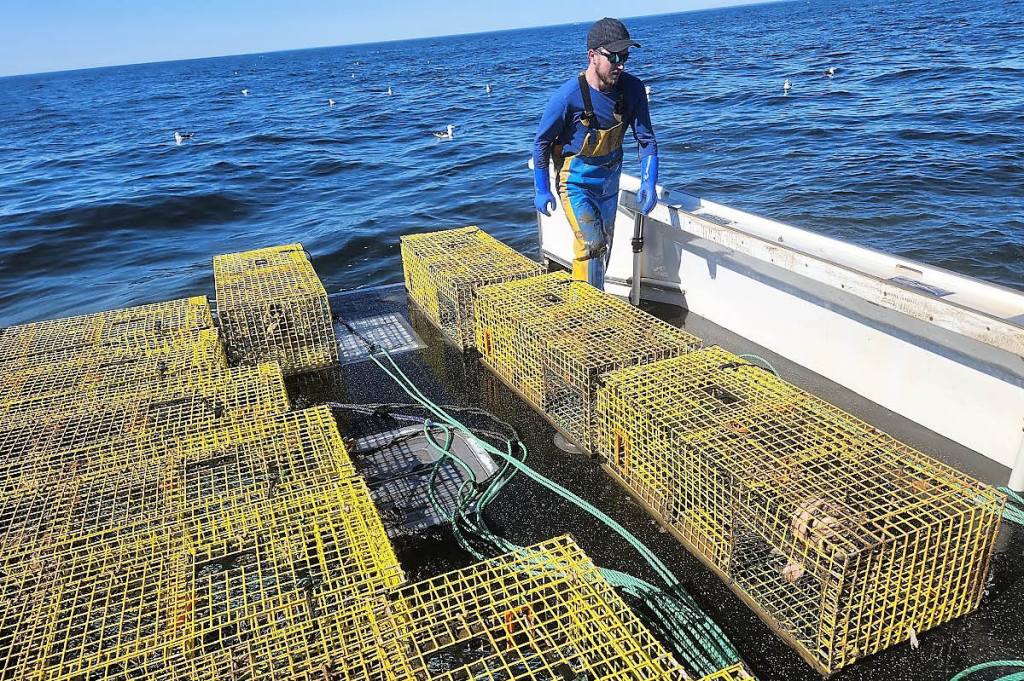
“Do you know how much insurance and how many boats and how many lives it’s going to cost to replicate the knowledge we have?” Jerry warns. “If you don’t tap into it now and learn from it, you can’t produce the next generation. Do you know how many people it takes to find a captain? Do you know how many guys I have to go through to find a crew? Two hundred guys might come to the wharf saying, ‘I want to be a fisherman.’ Then I take them out and they say, ‘Holy shit, this ain’t for me.’ So it took me 200 guys to find the one deck hand. So now I have five deck hands. And out of the 200 deck hands who are working down the coast, there might be one captain. Then you gotta train that guy to be a captain who’s in control of all of the guys on deck, who’s in control of his vessel, who’s in control of himself, who knows the areas, who knows the migration, who knows how to fix gear. These things are a dying art.”
NEFSA’s focus, Jerry says, is “outreach, outreach, outreach.” The organization has been meeting with the heads of agencies and fishing industry representatives of law- makers to urge some action on NOAA’s bad data. During an April Senate hearing, Senator Collins questioned commerce secretary Gina Raimondo about NOAA’s survey vessel not functioning properly, saying, “If you don’t know how many fish are out there, you can’t decide, accurately, what the quota is. And the fishermen are on the water every day. They have the best information about the state of the stock, and they’re not involved in the surveys.”
Raimondo responded, “We had a lot of problems, in Covid, staying on top of the surveys on time. We’re mostly caught up. I regret that we’re not caught up in Maine.”
Jerry says he hopes he’s “not too late” to save New England’s fishing and lobstering industry. But judging from some of his harrowing stories of life at sea, I’d say NOAA better batten down the hatches.
This article was originally published in The Spectator’s July 2023 World edition.



